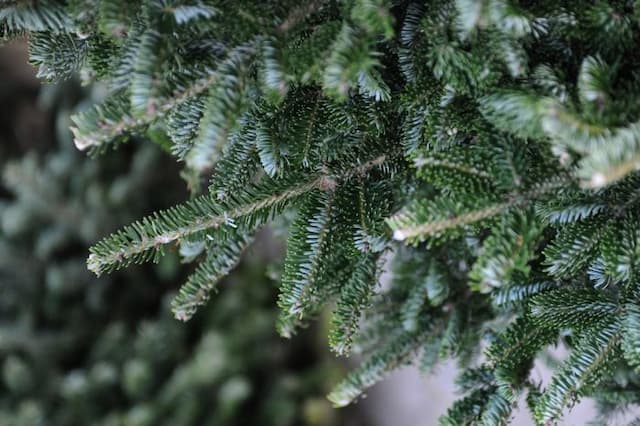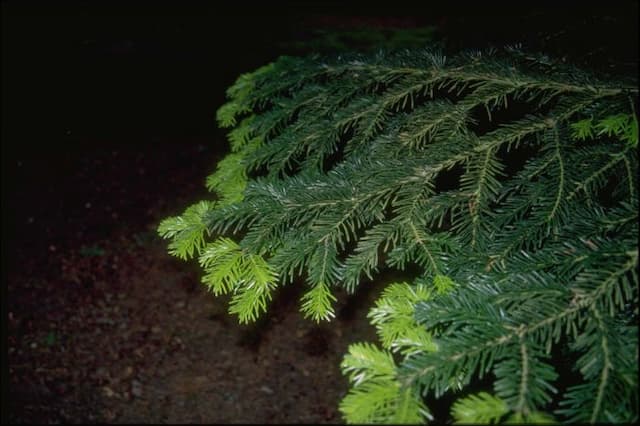Blue Spruce Picea pungens 'Blue Diamond'
ABOUT
The Blue Diamond spruce is best known for its striking blue needle-like leaves, which give it a distinctive, shimmering appearance. The needles emanate in all directions from the branches, creating a dense texture that adds to its visual interest. The foliage provides a year-round display of silvery-blue color, creating a cool-toned accent in any landscape. This spruce has a pyramidal or conical shape, typical of many evergreens, which tends to become more pronounced as it matures. It features sturdy branches that can support an array of ornaments if used as a living Christmas tree. The overall impression of the Blue Diamond spruce is of a robust, vibrant evergreen with a richly hued, captivating presence.
About this plant
 Names
NamesFamily
Pinaceae.
Synonyms
Blue Diamond Spruce, Colorado Blue Spruce, Blue Diamond Colorado Spruce.
Common names
Picea pungens.
 Toxicity
ToxicityTo humans
The Blue Spruce is generally not considered poisonous to humans. However, ingesting parts of the plant, particularly needles or sap, can be irritating to the mouth and stomach, potentially causing gastrointestinal discomfort. It is not commonly associated with severe toxicity in humans, but it is advisable to avoid consuming any part of this ornamental plant.
To pets
The Blue Spruce is also not specifically listed as toxic to pets. However, if pets chew on the needles, it could cause mild gastrointestinal upset such as vomiting or diarrhea. The sharp needles can also potentially cause irritation or damage to a pet's mouth and digestive tract. It's best to keep pets from ingesting this plant to avoid any possible discomfort or injury.
 Characteristics
CharacteristicsLife cycle
Perennials
Foliage type
Evergreen
Color of leaves
Blue-green
Height
6-10 feet (1.8-3 meters)
Spread
4-6 feet (1.2-1.8 meters)
Plant type
Tree
Hardiness zones
3-8
Native area
North America
Benefits
 General Benefits
General Benefits- Aesthetic Appeal: The Colorado Blue Spruce 'Blue Diamond' variety has a stunning silvery-blue foliage that adds a unique color accent to landscapes.
- Drought Tolerance: Once established, it is relatively drought-resistant, making it an excellent choice for xeriscaping and dry climates.
- Cold Hardy: It is very cold-hardy and can withstand harsh winter conditions, ideal for colder regions.
- Low Maintenance: It requires minimal care once established, with little need for pruning or pest control.
- Privacy Screen: The dense growth habit makes it an excellent choice for creating privacy screens or windbreaks.
- Habitat Support: Provides shelter and nesting sites for birds and other wildlife.
- Year-Round Interest: Its evergreen nature ensures that it provides color and structure to the garden throughout the year.
 Medical Properties
Medical PropertiesThis plant is not used for medical purposes.
 Air-purifying Qualities
Air-purifying QualitiesThis plant is not specifically known for air purifying qualities.
 Other Uses
Other Uses- Picea pungens 'Blue Diamond', commonly known as the Blue Spruce, can be used to create natural sound barriers due to its dense foliage, helping to reduce noise pollution effectively.
- The resin from Blue Spruce can be used in the production of specialized varnishes and adhesives due to its sticky and bonding properties.
- Wood from mature Blue Spruce trees is suitable for making musical instruments, especially soundboards for certain types of string instruments, where the wood's resonance enhances sound quality.
- When dried and treated, the needles of the Blue Spruce can be used to stuff traditional alpine pillows, which are believed to promote stress relief and better sleep.
- The Blue Spruce's sturdy branches are often harvested and crafted into rustic furniture such as chairs, benches, or tables, providing a natural and woodland aesthetic.
- In some cultures, the Blue Spruce cones are used in crafting and decorating, often painted and converted into ornaments or jewelry due to their unique shape and texture.
- The Blue Spruce's natural shape and rigidity make it an excellent choice for constructing outdoor privacy screens or living fences in landscape design.
- During the holiday season, smaller branches and twigs of the Blue Spruce may be used to create festive wreaths or garlands, treasured for their silver-blue color and durability.
- Some hobbyists use the scale-like texture of the Blue Spruce's bark in miniature modeling, such as creating realistic tree textures in model railways or dioramas.
- The essential oil derived from the Blue Spruce needles is used in perfumery and aromatherapy for its crisp and refreshing scent, reminiscent of forested wilderness.
Interesting Facts
 Feng Shui
Feng ShuiThe Colorado Blue Spruce is not used in Feng Shui practice.
 Zodiac Sign Compitability
Zodiac Sign CompitabilityThe Colorado Blue Spruce is not used in astrology practice.
 Plant Symbolism
Plant Symbolism- Strength and Resilience: The Blue Spruce, with its hardy nature and ability to withstand cold temperatures, is often associated with strength and the ability to endure challenging conditions.
- Longevity: Trees like the Blue Spruce can live for hundreds of years, making them symbols of longevity and everlasting life.
- Protection: With its evergreen needles, the Blue Spruce is believed to protect against negative energy and represent a sheltering presence.
- Peace and Tranquility: The blue-green hues of the Blue Spruce can evoke feelings of calm and peace, symbolizing tranquility and a serene retreat from the world.
 Water
WaterThe Blue Spruce should be watered deeply but infrequently, allowing the soil to dry out slightly between waterings. Generally, watering once a week with 1 to 1.5 gallons of water per square foot of root spread is sufficient during the growing season. In the winter months, reduce the frequency to accommodate the slower growth and cooler temperatures, but ensure the root ball does not completely dry out. Adjust the amount and frequency based on rainfall, temperature, and soil drainage, but always water slowly to allow deep soil penetration and avoid runoff.
 Light
LightThe Blue Spruce thrives best in full sun conditions with at least six hours of direct sunlight each day. It should be planted in a spot that has clear exposure to the sky, away from larger buildings or trees that could create significant shade. Partial shade can be tolerated, but for the healthiest growth and best blue needle color, full sun is recommended.
 Temperature
TemperatureThe Blue Spruce does well in a range of temperatures, ideally between 20°F and 70°F. It can tolerate winter lows down to about -20°F and summer highs up to 90°F but prefers the cooler end of this spectrum. Ensure it is placed in an area where it can be protected from extreme heat, particularly during the hottest parts of the day.
 Pruning
PruningPruning the Blue Spruce is generally for shaping and removing any dead or diseased branches. The best time to prune is in late winter or early spring before new growth starts. It should be pruned sparingly, as it does not respond well to heavy cutting. If necessary, annual light pruning can help maintain its desired shape and promote a healthy, dense growth habit.
 Cleaning
CleaningAs needed
 Soil
SoilThe best soil mix for the Colorado Blue Spruce (Picea pungens 'Blue Diamond') is one that is well-draining, with a mix of loam, peat, and sand. The ideal pH for this plant is slightly acidic to neutral, around 5.5 to 7.0.
 Repotting
RepottingColorado Blue Spruce (Picea pungens 'Blue Diamond') trees are slow-growing and do not require frequent repotting. They can be repotted every 3 to 5 years, or when the root system outgrows the current container.
 Humidity & Misting
Humidity & MistingColorado Blue Spruce (Picea pungens 'Blue Diamond') thrives in average outdoor humidity. It does not require a specific humidity level but prefers a natural, unaltered outdoor environment.
 Suitable locations
Suitable locationsIndoor
Provide full sunlight and cool conditions for Colorado Blue Spruce indoors.
Outdoor
In well-drained soil, full sun, the Colorado Blue Spruce thrives outdoors.
Hardiness zone
2-7 USDA
 Life cycle
Life cycleThe Colorado Blue Spruce 'Blue Diamond' begins its life as a seed, which will germinate given the right conditions of moisture and temperature. Upon germination, the seedling emerges and establishes itself with a primary root and shoots, entering the juvenile phase where it grows steadily with needle-like leaves that exhibit its characteristic blue color. The sapling stage follows, during which the young tree develops its strong woody stem and branching structure, continuing to grow in height and girth. Sexual maturity is reached after several years, and the tree begins to produce cones—male cones release pollen while female cones are fertilized and develop seeds. Once mature, the Colorado Blue Spruce can live for many decades, even centuries, continuously producing cones and seeds annually during its reproductive phase. At the end of its lifespan, the Colorado Blue Spruce naturally dies, decomposes, and returns nutrients to the soil, thereby supporting new plant life in its ecosystem.
 Propogation
PropogationPropogation time
Early Spring
Propogation: The most popular method of propagating the Colorado Blue Spruce, known scientifically as Picea pungens 'Blue Diamond', is through seed germination. Seeds are typically sown in late winter to early spring, after a period of stratification, which involves chilling the seeds for a period of 3-4 weeks at a temperature of approximately 33-41 degrees Fahrenheit (0.5-5 degrees Celsius) to break dormancy. They are then planted in well-drained soil, covered lightly with a fine layer of substrate, and kept moist. Consistent moisture and cool temperatures are vital to ensure successful germination. Seedlings usually emerge after a few weeks and require careful attention to prevent desiccation or damping off, a common fungal disease in seedlings. With time, patience, and the right conditions, these seeds will grow into the iconic blue-needled trees known for their ornamental value.









